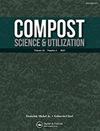Vermicompost and Manure Compost Reduce Water-Deficit Stress in Pot Marigold (Calendula officinalis L. cv. Candyman Orange)
IF 0.9
4区 农林科学
Q3 ECOLOGY
引用次数: 16
Abstract
Abstract This study was carried out to evaluate the impact of irrigation regime and potting media on morpho-physiological and biochemical characteristics of pot marigold. The experiment was arranged factorially based on a completely randomized design. The first factor was irrigation regime in three levels of 80, 60 and 40% available water content and the second factor was potting media in five levels of 20% vermicompost, 30% vermicompost, 20% manure compost, 30% manure compost and control (sand and soil in equal proportions). Morpho-physiological traits (plant height, stem diameter, number of flowering stem, root diameter, root length, root dry weight, aerial dry weight, total dry weight, relative water content, ionic stability and water use efficiency) and biochemical traits (malondialdehyde content, catalase and peroxidase activity, chlorophyll and carotenoid contents) were measured. Morpho-physiological parameters, chlorophyll and carotenoid decreased under water deficit, while increased with application of vermicompost and manure compost. Also, lipid peroxidation, catalase and peroxidase activity enhanced under water deficit, while decreased with application of vermicompost and manure compost. In other words, the application of vermicompost and manure compost in potting media reduced the harmful effects of water deficit. Total dry mass and water use efficiency were about 3-fold higher in plants grown in 30% vermicompost or 30% manure compost substrate compared to those in control plants. The results suggest that the application of 30% manure compost could be recommended as suitable potting media due to reducing the negative effects of water shortages, helping to nourish the plant, cheapness and accessibility compared with 30% vermicompost.蚯蚓堆肥和粪肥堆肥降低盆栽万寿菊水分亏缺胁迫。甜心宝贝橙色)
摘要本研究旨在评价灌溉制度和盆栽介质对盆栽万寿菊形态生理生化特性的影响。实验是在完全随机设计的基础上按因素安排的。第一个因素是三个水平的灌溉制度,即80%、60%和40%的有效含水量,第二个因素是五个水平的盆栽介质,即20%的蚯蚓堆肥、30%的蚯蚓堆肥,20%的粪肥堆肥、30%粪肥堆肥和对照(沙和土壤比例相等)。测定了形态生理性状(株高、茎径、花茎数、根径、根长、根干重、地上干重、总干重、相对含水量、离子稳定性和水分利用效率)和生化性状(丙二醛含量、过氧化氢酶和过氧化物酶活性、叶绿素和类胡萝卜素含量)。形态生理参数、叶绿素和类胡萝卜素在缺水条件下降低,而随着施用蚯蚓粪和粪肥的增加而增加。水分亏缺时,脂质过氧化、过氧化氢酶和过氧化物酶活性增强,而施用蚯蚓粪和粪肥时,脂质过氧化物酶、过氧化氢酶、过氧化物酶活性降低。换句话说,在盆栽介质中应用蚯蚓堆肥和粪肥堆肥减少了缺水的有害影响。与对照植物相比,在30%蚯蚓堆肥或30%粪肥堆肥基质中生长的植物的总干质量和水分利用效率高出约3倍。结果表明,与30%的蚯蚓堆肥相比,30%的粪肥堆肥可以作为合适的盆栽介质,因为它可以减少缺水的负面影响,有助于滋养植物,价格低廉,易于接近。
本文章由计算机程序翻译,如有差异,请以英文原文为准。
求助全文
约1分钟内获得全文
求助全文
来源期刊

Compost Science & Utilization
农林科学-生态学
CiteScore
4.10
自引率
0.00%
发文量
0
审稿时长
>36 weeks
期刊介绍:
4 issues per year
Compost Science & Utilization is currently abstracted/indexed in: CABI Agriculture & Environment Abstracts, CSA Biotechnology and Environmental Engineering Abstracts, EBSCOhost Abstracts, Elsevier Compendex and GEOBASE Abstracts, PubMed, ProQuest Science Abstracts, and Thomson Reuters Biological Abstracts and Science Citation Index
 求助内容:
求助内容: 应助结果提醒方式:
应助结果提醒方式:


